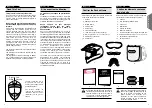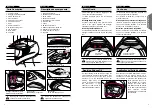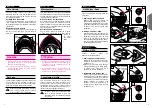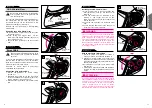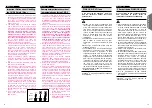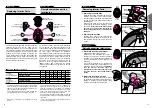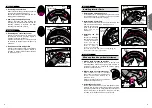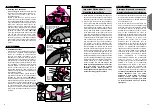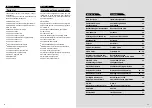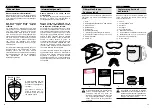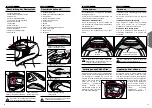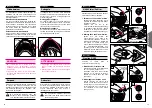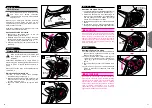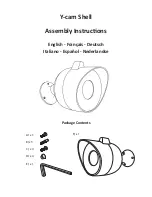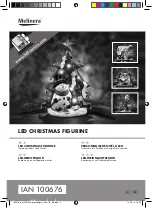
11
12
Englis
h
/Françai
s
Important Notice about Handling
the CNS-2 Shield / Visor
Remarque importante concernant
la manipulation de l’écran CNS-2
E n g l i s h
F r a n ç a i s
Size
(No.2)
Taille
(No.2)
✓
1. La salissure et les rayures sur l’écran peuvent
obstruer votre visibilité lorsque vous roulez, ce
qui peut être très dangereux. Cessez
immédiatement d’utiliser l’écran CNS-2 si il est
sale ou rayée. Retirez l’écran et nettoyez-le ou
remplacez-le.
2. Nettoyez l’écran CNS-2 avec une solution
d’eau et de savon doux au pH neutre. Rincez
bien à l’eau claire, puis essuyez les résidus
d’eau avec un chiffon doux. N’utilisez pas les
substances suivantes : eau chaude
dépassant 40°C, eau salée, détergeant à
base d’acide ou d’alcali, benzène, diluant,
essence ou autres solvants organiques,
nettoyant pour vitres ou autres nettoyants à
base de solvants organiques. Utiliser l’un de
ces nettoyants peut modifier la nature chimique
de l’écran et en entraver la sécurité.
3. Ne jamais rouler avec un écran embué. Cela
risque de gêner la visibilité et peut s’avérer
très dangereux. Si l’écran CNS-2 est
embué, ouvrir l’entrée d’air inférieure pour
faire circuler l’air à l’intérieur du casque et
supprimer la buée. Le film anti-buée
PINLOCK
®
EVO est également efficace pour
empêcher la formation de buée.
4. Utilisez toujours une lentille antibuée
PINLOCK
®
EVO originale SHOEI pour la
CNS-2. Pour la fixer, veuillez vous reporter aux
instructions comprises dans son emballage.
5. Retirez le film protecteur avant d’utiliser l’écran
pour la première fois.
6. Après avoir nettoyé ou remplacé les plaques
d’embase, fermez l’écran et assurez-vous qu’il
est bien en contact avec le bourrelet de l’écran
sur tout le pourtour. S’il y a un espace entre
l’écran et le bourrelet, réglez la position de la
plaque d’embase et éliminez l’espace car il
permettrait au vent et au bruit de s’introduire
dans le casque.
7. Pour serrer les vis, tenez verticalement un
tournevis cruciforme n° 2 dans la fente de la
vis et faites-le tourner avec précaution.
L’utilisation d’un tournevis inapproprié ou d’une
visseuse électrique peut endommager la tête
de la vis. Utilisez un véritable tournevis en
aluminium. Ne serrez pas trop les vis pour ne
pas les casser (couple
recommandé : 80 cN.m ou 8
kgf.cm environ).
8. Ne collez aucun autocollant ou
ruban adhésif dans le champ
de vision de l’écran.
1. Dirt and scratches on the shield / visor may
obstruct your view while riding and can be
very dangerous! If the CNS-2 shield / visor
gets dirty or scratched, stop using it
immediately. Remove the shield / visor and
clean or replace it.
2. The CNS-2 shield / visor should be cleaned
with a solution of mild, neutral soap and
water. Rinse well with pure water then wipe
dry with a soft cloth. Do not use any of the
following cleaning materials: hot water
over 40°C; salt water; any acidic or alkali
detergent; benzine, thinner, gasoline, or
other organic solvents; glass cleaner; or
any cleaner containing organic solvents. If
any of these cleaners are used, the
shield’s / visor’s chemical nature may be
altered and safety may be hindered.
3. Do not ride with a shield / visor that is fogged.
This may obstruct your view and can be very
dangerous. If the CNS-2 shield / visor is
fogged, open the lower air intake and / or
open the shield / visor to circulate air within
the helmet and remove the fog from the
shield / visor. Use of the PINLOCK
®
EVO lens
is also effective in stopping fog.
4. Always use SHOEI’s genuine PINLOCK
®
EVO lens for CNS-2. For fitting PINLOCK
®
EVO lens, please read instructions enclosed
in it.
5. Remove the protective film before using the
shield / visor for the first time.
6. After cleaning or replacing the base plates,
close the shield / visor and make sure that it
touches the window beading in all around. If
there is a gap between the shield / visor and
the window beading, adjust a position of the
base plate and eliminate the gap, because it
may cause roll-in of wind or noise.
7. For tightening screws, apply No.2 size
Phillips head screwdriver vertically and rotate
it carefully. If improper sized screwdriver or
electric screwdriver is used, a screw head
may be broken. Use a genuine screw made
of aluminum for replacement. If a screw is
tightened too much, it may be broken.
(Recommended torque: 80 cN.m or about 8
kgf.cm)
8. Do not place any sticker or
tape in the shield’s / visor’s
field of vision.
E n g l i s h
F r a n ç a i s
Film antibuée PINLOCK
®
EVO
Film antibuée Pinlock EVO
®
If you are using the PINLOCK
®
* EVO lens,
read the instruction manual that comes
packed with it.
*PINLOCK
®
is a registered trademark of PINLOCK
SYSTEMS B.V.
*PINLOCK
®
est une marque déposée de
PINLOCK SYSTEMS B.V.
Si vous utilisez un film antibuée PINLOCK
®
EVO* disponible en option, suivez les
instructions contenues dans l’emballage.
PINLOCK
®
EVO lens
1. Daytime use only. Never use PINLOCK
®
EVO
lens at night. If the PINLOCK
®
EVO lens is used
with a clear shield / visor, its light transmission
ratio will be approximately 80%. This value
does not meet the light transmission standards
in the U.S. (VESC-8, 85%), Australia (AS1609,
85%), or Europe (ECE R22, 80%), so this
accessory is for “daytime use only” in these
jurisdictions.
2. The PINLOCK
®
EVO lens is made of a material
that is easier to scratch than the outer
shield / visor. It should be treated with great
care.
3. Remove the protective film before using the
PINLOCK
®
EVO lens.
4. The PINLOCK
®
EVO lens demonstrates high
effectiveness in stopping fog by absorbing
moisture. However, if the helmet is used
continuously with the lower vent in the closed
position in low-temperature, high-humidity
conditions, the lens can become saturated with
water vapor causing streaks and fog to appear.
If streaks or fog appears, it may obstruct your
view and be very dangerous! In this case, open
the lower air intake and / or open the
shield / visor to circulate air within the helmet to
remove the streaks and fog from the helmet.
5.Purchase DKS302 for CNS-2 for replacement of
PINLOCK
®
EVO lens.
1.Pour utilisation diurne uniquement. Ne jamais
utiliser le film antibuée PINLOCK
®
EVO la nuit.
Si le film antibuée PINLOCK
®
EVO est utilisé
avec un écran transparent, le ratio de
transmission lumineuse sera d’environs 80%.
Cette valeur n’attend pas les normes de
transmission exigées aux Etats Unis (VESC-8,
85%), en Australie (AS1609, 85%), ou en
Europe (ECE R22, 80%), cet accessoire est
donc pour une utilisation diurne uniquement («
Daytime Use Only ») dans ces juridictions.
2.Le film antibuée PINLOCK
®
EVO est fabriquée
dans un matériau qui se raye plus facilement
que celui de l’écran extérieure. Veillez donc à la
manipuler avec précaution.
3.Retirez le film protecteur avant d’utiliser le film
antibuée PINLOCK
®
EVO.
4.Le film antibuée PINLOCK
®
EVO empêche très
efficacement la formation de buée en absorbant
l’humidité. Mais si le casque est utilisé en
permanence avec l’orifice de ventilation
inférieur fermé à basse température, dans des
conditions très humides, la vapeur d’eau peut
saturer sur le film et des trainées de buée
peuvent alors apparaître, ce qui peut obstruer
votre visibilité et être très dangereux. Dans ce
cas, ouvrez la prise d’air inférieure et/ou ouvrez
l’écran pour faire circuler l’air dans le casque et
éliminer ainsi les traînées et la buée du casque.
5. Lors du remplacement du film antibuée
PINLOCK
®
EVO , choisissez le modèle DKS302
pour CNS-2.
HORNET ADV/X2(P11-12)



